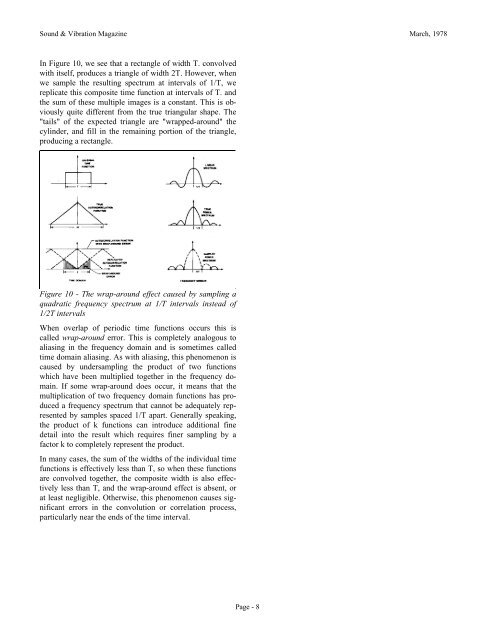Fundamentals of the Discrete Fourier Transform
Fundamentals of the Discrete Fourier Transform
Fundamentals of the Discrete Fourier Transform
You also want an ePaper? Increase the reach of your titles
YUMPU automatically turns print PDFs into web optimized ePapers that Google loves.
Sound & Vibration Magazine March, 1978<br />
In Figure 10, we see that a rectangle <strong>of</strong> width T. convolved<br />
with itself, produces a triangle <strong>of</strong> width 2T. However, when<br />
we sample <strong>the</strong> resulting spectrum at intervals <strong>of</strong> 1/T, we<br />
replicate this composite time function at intervals <strong>of</strong> T. and<br />
<strong>the</strong> sum <strong>of</strong> <strong>the</strong>se multiple images is a constant. This is obviously<br />
quite different from <strong>the</strong> true triangular shape. The<br />
"tails" <strong>of</strong> <strong>the</strong> expected triangle are "wrapped-around" <strong>the</strong><br />
cylinder, and fill in <strong>the</strong> remaining portion <strong>of</strong> <strong>the</strong> triangle,<br />
producing a rectangle.<br />
Figure 10 - The wrap-around effect caused by sampling a<br />
quadratic frequency spectrum at 1/T intervals instead <strong>of</strong><br />
1/2T intervals<br />
When overlap <strong>of</strong> periodic time functions occurs this is<br />
called wrap-around error. This is completely analogous to<br />
aliasing in <strong>the</strong> frequency domain and is sometimes called<br />
time domain aliasing. As with aliasing, this phenomenon is<br />
caused by undersampling <strong>the</strong> product <strong>of</strong> two functions<br />
which have been multiplied toge<strong>the</strong>r in <strong>the</strong> frequency domain.<br />
If some wrap-around does occur, it means that <strong>the</strong><br />
multiplication <strong>of</strong> two frequency domain functions has produced<br />
a frequency spectrum that cannot be adequately represented<br />
by samples spaced 1/T apart. Generally speaking,<br />
<strong>the</strong> product <strong>of</strong> k functions can introduce additional fine<br />
detail into <strong>the</strong> result which requires finer sampling by a<br />
factor k to completely represent <strong>the</strong> product.<br />
In many cases, <strong>the</strong> sum <strong>of</strong> <strong>the</strong> widths <strong>of</strong> <strong>the</strong> individual time<br />
functions is effectively less than T, so when <strong>the</strong>se functions<br />
are convolved toge<strong>the</strong>r, <strong>the</strong> composite width is also effectively<br />
less than T, and <strong>the</strong> wrap-around effect is absent, or<br />
at least negligible. O<strong>the</strong>rwise, this phenomenon causes significant<br />
errors in <strong>the</strong> convolution or correlation process,<br />
particularly near <strong>the</strong> ends <strong>of</strong> <strong>the</strong> time interval.<br />
Page - 8


